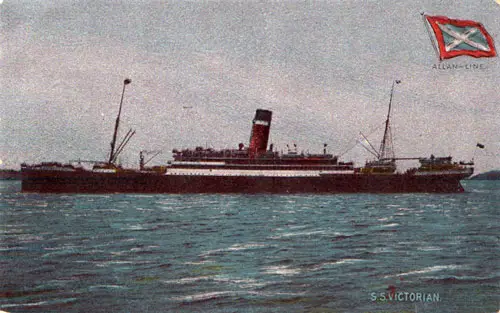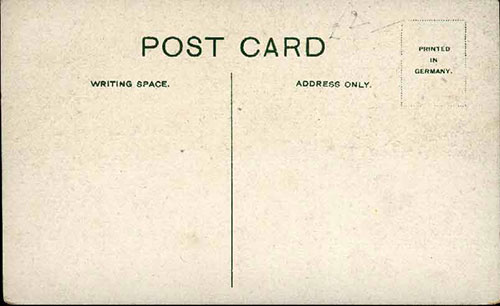Vintage Postcards of the Allan Line Steamship SS Victorian - GG Archives
Colorized vintage postcard photo of the SS Victorian of the Allan Line. Unused postcard depicts this steamship near the shoreline with flag of the Allan Line shown on upper right corner. She is the sister ship of the SS Virginian at 12,000 Tons

Title: Allan Line SS Victorian
Manufacture: Unknown
Date: Undated but circa 1910
Manufactured: Printed in Great Germany
Description: Remarkable early 1900s postcard showing a view of the Allan Line Steamer SS Victorian. The postcard has a divided back and is unused.
Archives Inventory Number: GGA-ATL 739728288

The First Turbine Transatlantic Steamship
An epoch-making ship was recently launched from the shipbuilding yard of Messrs. Workman, Clark & Co., at Belfast, Ireland, for the Allan Steamship Line. This new vessel, named the “Victorian," is the pioneer turbine steamship for the Atlantic or any other ocean service, and as such her launch is an event of widespread interest. She is the first of the two turbine-driven ships ordered by the Allan Line, her sister ship being the “Virginian,” which is now in course of construction on the Clyde, and both are identical in their dimensions, capacity and power.
For a considerable time prior to the letting of the contracts, it was debated whether the turbine would be practicable as a means of propelling the giant ships that carry the great cross-Atlantic passenger traffic, and, while other steamship companies were looking for more light on the subject and hesitating to plunge into a practical experiment that might involve heavy losses, the Allan Company boldly assumed the responsibility of determining the turbine‘s value in this new sphere.
It was originally intended that the “Victorian” was to be driven by reciprocating engines, and this idea was adhered to even after the builders had progressed to a considerable extent with her hull. The steamship company then decided that she should be equipped with turbines instead, when the necessary alterations in her structural design were made to conform to the new conditions. An agreement having been entered into between the Allan Steamship Company and the Parsons Turbine Company, the gigantic and difficult task of constructing the largest turbines ever designed was commenced.
A high-pressure and two low-pressure turbines will drive the three propellers of the ship, which, by the way, strike one as being unusually small to propel a monster possessing a cargo-capacity of more than 8,000 tons, besides accommodations and equipment for nearly 1.300 passengers. The propellers are made small, however, since they revolve at a very high speed, that is to say, from 270 to 300 revolutions per minute.
The central propeller is arranged as in a single-screw vessel, and this is operated by the high-pressure turbine; the others are arranged as in a twin-screw ship, with the low-pressure turbines. Each of the latter has a reversing arrangement, which enables them to be driven full speed astern, either together or independently, and in this way the ship will be as easily and as effectively maneuvered, as, for instance, in turning or backing, as an ordinary twin-screw. This disposes of the objection which has sometimes been urged against tur~ bines, that they are defective in the matter of reversing.
The principle of the steam turbine to be used in the marine service is precisely the same as those designed for stationary work. Briefly, a turbine engine is a fixed cylinder having upon its inside surface mounted rings, containing blades projecting radially inward. The moving element consists of a driver, having on its peripheral surface similar rings with blades set at an angle to the fixed blades, the whole being arranged to revolve inside with just enough space to clear each other.
Steam is admitted in one end of the turbine and passes through longitudinally in a zig-zag path, being deflected from the fixed rows of blades in the turbine casing against the rows of blades on the revolving drum, causing the latter, which is connected to the propeller shafting, to revolve, and so drive the ship. The fixed blades of the cylinder act as guides to deliver the steam with proper direction and velocity against the moving blades on the drum, so that the full power of the steam is utilized in a direct and continuous way.
The word “blades," when used in connection with the machinery of an ocean liner, seems to suggest a screw-propeller, but the blades of a turbine are very small, not larger than a girl's little finger; but it is the prodigious number of the blades employed, there being no less than a million and a half separate pieces used in the three turbines of the “Victorian,” that enables the full power of the steam to be used, down to the last ounce, in a direct and continuous way.
The economy of space obtained by the use of the steam turbine has enabled the builders to provide accommodations on board the “Victorian" such as is probably not equaled by any other vessel of her size afloat.
This saving has not been utilized to increase the number of passengers carried, but to give every possible comfort and luxury to the three classes of passengers. The “Victorian" will be, first of all, a comfortable ship in so far as perfection of appointment can make her so.
The steam to drive the turbines will be generated by eight large boilers of the usual marine type. The length of the “Victorian" is 540 feet, her breadth 60 feet, her depth 40 feet 6 inches. She is divided by bulkheads into eleven compartments, and, with the subdivisions of her double bottom, she has twenty watertight spaces.
She is built to the highest class of the British Corporation Registry of Shipping, and her hull has been specially strengthened above the requirements of the corporation, in order to make her doubly secure against the heavy weather of the North Atlantic, for it is intended to employ her in the Canadian mail service. Added to this, she will be surveyed and passed by the Board of Trade for a passenger certificate, and will also be fitted in conformity with the American laws for passenger steamers.
The first-class accommodation, as usual, is amidships, and is of the most complete and approved order. Perfectly heated and ventilated staterooms, a spacious and well-fitted dining-saloon, and elegantly appointed music-room and a luxuriously equipped smoking-room are some of the features. Not less comfortable, proportionately, are the second-class quarters, and the third class passengers are provided for in the most liberal manner.
The entire vessel is equipped throughout with electric light. A complete printing outfit and an installation of the Marconi wireless telegraph are among the arrangements looking toward the comfort and convenience of passengers. The facilities for handling the cargo are as complete and perfect as it is possible to fit a ship; she has no less than ten steam winches for working the hold, and she is provided with insulated chambers and a refrigerating plant, so as to enable her to carry fruit, dairy produce, etc., from Canada.
As it has already been indicated, the “Victorian" is largely an experimental ship. Turbines have proven a success for small channel steamers, but whether they will be equally as successful for ocean steamship: remains to be seen.
The trial-trip of the “Victorian” will practically solve this problem, and if the deductions of the naval engineers are found to be correct the speed of the new vessel will be much greater than any other steamer on the same route; and it is confidently expected by the builders that, under favorable conditions, the voyage to Canada will be shortened by at least a day. If such is the case this vessel will prove an important factor in the development of England's growing trade with her colonies.
Whatever the result may be, with the Allan Line rests the honor of leading the way with an important economical venture, and with Messrs. Workman, Clark & Co. of conducting a new departure in shipbuilding and engineering science, which may result in a final revolution of the character of the ocean liner.
Source: A. C. Frederick, “The First Turbine Transatlantic Steamship,” in The American Inventor, New York, Volume 12, No24 December 15, 1904, P. 507-508
